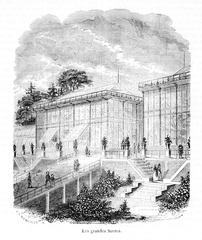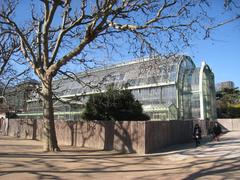
Visiting the Grandes Serres du Jardin des Plantes Paris: A Complete Guide
Date: 14/06/2025
Introduction: History and Significance
Nestled within Paris’s illustrious Jardin des Plantes, the Grandes Serres (Great Greenhouses) stand as monuments to centuries of botanical exploration and architectural innovation. Established in 1635 as the Jardin Royal des Plantes Médicinales under Louis XIII, the garden evolved into a bastion of scientific inquiry, global plant acclimatization, and public education. The Grandes Serres, constructed mainly in the 19th and 20th centuries, showcase diverse biomes—from tropical rainforests to New Caledonia’s unique flora—beneath breathtaking iron-and-glass roofs, now classified as historical monuments (France Today, Jardin des Plantes, The Connexion).
A visit here is a journey through botanical marvels and centuries of Parisian cultural heritage, making it a must-see for plant lovers, history buffs, and curious travelers alike.
Contents
- Historical Overview
- Origins and Early Development (17th–18th Centuries)
- 19th Century Architectural Innovation
- Botanical and Scientific Contributions
- Restoration and Modernization
- The Four Greenhouses: Diversity Unveiled
- Visitor Information: Tickets, Hours, Accessibility
- Special Exhibitions and Events
- Travel Tips
- Nearby Attractions
- Frequently Asked Questions (FAQ)
- Summary & Final Tips
- Sources
Historical Overview
Origins and Early Development (17th–18th Centuries)
The Jardin des Plantes began as a royal medicinal herb garden, rapidly expanding under Enlightenment botanists like Joseph Pitton de Tournefort. The garden’s first greenhouse, built in 1714 for a Coffea arabica plant, symbolized France’s early engagement with tropical flora and set the stage for future botanical acclimatization (France Today, Jardin des Plantes).
19th Century Architectural Innovation
After the French Revolution, the garden was integrated into the Muséum National d’Histoire Naturelle (MNHN), broadening its scientific mission. Architect Charles Rohault de Fleury’s 1830s cast-iron and glass structures—among Europe’s earliest and most innovative—heralded a new era in greenhouse design. Later, René Berger’s 1930s Art Deco “jardin d’hiver” further elevated the site’s architectural prestige (Bonjour Paris, Wikipedia).
Botanical and Scientific Contributions
The Grandes Serres have long served as living laboratories for research in plant taxonomy, physiology, and adaptation. They played a pivotal role in introducing and acclimatizing economically significant species—such as coffee—and continue to facilitate research and conservation today (Jardin des Plantes, France Today).
Restoration and Modernization
The greenhouses have survived wartime adversity and urban transformations, with 20th and 21st-century restorations modernizing facilities and reinforcing conservation. The addition of specialized greenhouses—such as those dedicated to New Caledonia and plant evolution—reflects ongoing scientific and educational priorities (The Garden History Blog).
Since 1993, the Grandes Serres have been officially recognized as historical monuments, underscoring their cultural and scientific value (Wikipedia).
The Four Greenhouses: A Global Botanical Journey
1. Serre des Forêts Tropicales Humides (Tropical Rainforest Greenhouse)
Step into a lush, cathedral-like Art Deco greenhouse simulating a tropical jungle. Here, towering banana and palm trees, dense ferns, and vibrant orchids thrive in carefully controlled equatorial conditions. Educational panels explain plant adaptations, while a central rock formation offers panoramic views. The annual “Mille et une Orchidées” exhibition transforms this space into a floral spectacle each winter (Jardin des Plantes Official, MNHN Exhibition).
2. Serre des Déserts et Milieux Arides (Desert and Arid Environments Greenhouse)
Contrast the rainforest’s humidity with the dry, sunbaked ambiance of the desert greenhouse. Here, cacti and succulents from the Americas, Africa, and Australia demonstrate remarkable survival strategies. Exhibits highlight water-saving adaptations and the importance of arid ecosystem conservation (Jardin des Plantes).
3. Serre de Nouvelle-Calédonie (New Caledonia Greenhouse)
Showcasing the flora of New Caledonia—a biodiversity hotspot with over 75% endemic plants—this greenhouse features ancient Araucaria trees, nickel hyperaccumulators, and endangered species threatened by mining. Interpretive displays detail the island’s unique ecology (World in Paris).
4. Serre de l’Histoire des Plantes (Plant Evolution Greenhouse)
Trace 430 million years of plant evolution, from primitive mosses to flowering plants. Fossil specimens, living “fossil” plants, and interactive exhibits reveal the pivotal role of plants in shaping Earth’s ecosystems. This greenhouse is particularly popular with families and schools (Jardin des Plantes).
Visitor Information: Tickets, Hours, Accessibility
Opening Hours (2025)
- Open: Daily except Tuesdays
- Hours: 10:00–18:00 (October–February: 10:00–17:00)
- Last Entry: 1 hour before closing
- Closed: January 1, May 1, December 25, and during extreme weather (Jardin des Plantes)
Tickets and Prices
- Adults: €9
- Reduced Rate: €7 (students, seniors, etc.)
- Family Pass: €28 (2 adults + 2 youths aged 3–25)
- Children: Free for young children (see official site for age limits)
- Purchase: Online (recommended) or at the entrance
Accessibility
- Wheelchair Access: As of June 2025, lift access is temporarily unavailable. Check the official accessibility page for updates.
- Rest Areas: Benches throughout; accessible restrooms nearby.
- Assistance: Staff can provide support; contact in advance if needed.
Facilities
- Clean restrooms, cafés, and a gift shop are within the Jardin des Plantes grounds.
Special Exhibitions and Events
Mille et une Orchidées (A Thousand and One Orchids)
Each February to March, the tropical greenhouse hosts a dazzling orchid festival. Hundreds of orchids are displayed in creative arrangements, accompanied by expert-led tours, workshops, and a large pop-up boutique selling rare orchids (Sortir à Paris, MNHN Exhibition).
Guided Tours and Educational Activities
Occasional guided tours and workshops provide deeper insight into the plant collections and their conservation. These are especially frequent during special events. Advance booking is advised.
Travel Tips
- Best Time to Visit: Weekday mornings are quietest.
- Getting There: Metro Lines 5, 7, 10; RER C; Batobus; close to Gare d’Austerlitz and Gare de Lyon.
- Duration: Allow at least 1–2 hours.
- Photography: Non-flash photography is encouraged.
- Attire: Dress in layers; greenhouses can be warm and humid.
- Language: Most signage is in French; some English available.
- Etiquette: Do not touch or pick plants; eating/drinking is not permitted inside.
Nearby Attractions
- Ménagerie (Zoo): Historic zoo with rare species
- Grande Galerie de l’Évolution: Interactive natural history displays
- Galerie de Paléontologie et d’Anatomie Comparée: Fossils and anatomical collections
- Jardin Alpin: Alpine plants (Sortir à Paris)
Combo tickets may be available; see the official ticketing page.
Frequently Asked Questions (FAQ)
Q: Are the Grandes Serres open all year?
A: Yes, except Tuesdays and certain holidays.
Q: Can I buy tickets on-site?
A: Yes, but online purchase is recommended to avoid queues.
Q: Are the Grandes Serres wheelchair accessible?
A: Temporary lift outage as of June 2025—check for updates.
Q: Can I take photos inside?
A: Yes, non-flash photography is permitted.
Q: Are guided tours available?
A: Occasionally, especially during events—check the agenda.
Summary and Final Tips
The Grandes Serres du Jardin des Plantes offer an exceptional blend of history, architecture, and botanical diversity. Through world-class plant collections and immersive exhibitions, they serve as living classrooms and treasured Parisian landmarks. Plan your visit using up-to-date information, enjoy the serenity of the greenhouses, and don’t miss seasonal events like “Mille et une Orchidées.”
For the latest updates, tickets, and event details, visit the official Jardin des Plantes website and consider using the Audiala app for guided tours and real-time visitor tips.
Sources
- France Today
- The Connexion
- Jardin des Plantes Official
- Jardin des Plantes – Mille et une Orchidées
- The Garden History Blog
- Bonjour Paris
- Wikipedia
- Pariscrea
- Sortir à Paris
- World in Paris
- Paris Insiders Guide








































































































































































































































